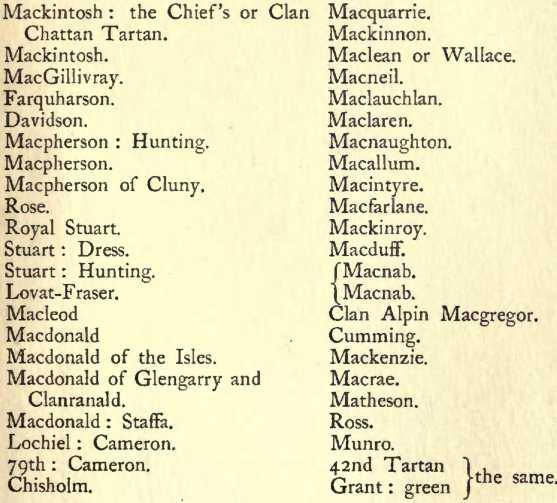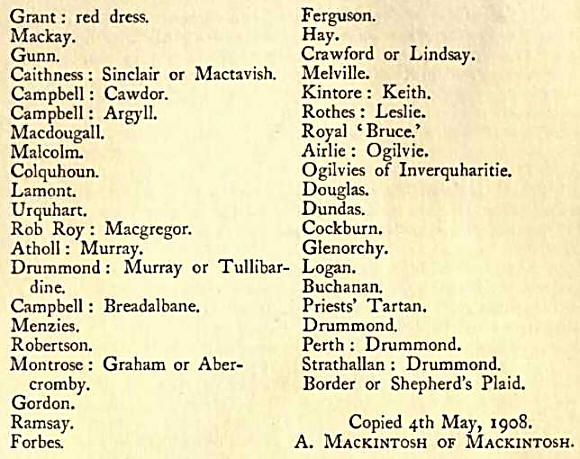LOWLAND
TARTAN'S (S.H.R. v. 367). Mr. H. A. Cockburn asked in your
columns whether any Lowland tartan« appear in ‘the old
collection of tartans’ which is at Moy Hall, and I took
steps to inquire.
The Mackintosh kindly sent me the list, and as—though
undertaker much nearer our own time than Mr. Cockburn
probably imagined—it was a genuine attempt on the part of a
Highland chieftain to get to the bottom of the tartan
question, it is well worth placing on record.
On the first page is written:
Scottish Tartans collected through the agency of Mr.
Macdougall of Inverness in the year 1848. They are believed
to be the only authentic tartans, and are bound by me
Alexander Mackintosh of Mackintosh, 1873, with a view to
their preservation as the only authentic tartans.
The list is as follows:


Now when
dealing with this list we must remember that we are
considering tartans only, and rot the origin of Highland
families and names. The Norman-born Stewarts held dominion
over Highland and Lowland, and so in a lesser degree did
many a Southern brood. Their following was of their
territory, not of their blood. Frasers, Hays, and Gordons,
and a score of others, at some period took the tartan from
their environment, and to a certain extent gave their name
to a district and lost their distinctive Lowland character.
When Mr. Cockburn wishes to know whether there is any proof
of the antiquity of Lowland tartans, we must confine
ourselves to those families which had no connection with the
Highlands. In this list we will set: that his own
Berwickshire patronymic has to back it only Douglas and
Dundas. For the rest of us on the Border there is only
shepherd’s plaid; I believe quite rightly.
If Sir Walter Scott, steeped in historic lore, keen to rake
up traditions, and born nearly a century and a half ago—in
the days before the dividing lines were smudged over by
frequent intercommunications—had no faith in Lowland
tartans, it would be rash of us to think otherwise to-day.
It is possible also to propound an argument in favour of
this contention.
It would be a bold man who would dogmatise as to the
evolution of a Highland clan and as to the period at which
certain combinations of colour were acknowledged as the
joint property of a certain territory or sept, but we do
know that from early days the old Highlanders were fond of
bright hues, that they were cunning with the dye-pot, and
that they remembered the Celtic tradition of many
interlacing lines. When it came to fighting they wanted to
travel light, and on foot. Coat armour and closed helmets
were almost unknown among them. The true Highland chieftain
was only primus inter pares, and he and his followers alike
snatched their badges from the hillside, and the plaid
became their uniform.
In the low country, where the steel-clad mounted man was
everything, matters were quite different. From the first
dawn of heraldry the shield, the crest, the banner of the
knight were the sign and the rallying point in battle. It is
hardly too much to say that heraldry dominated medieval
warfare. But, unless they were of his male kin, the knight’s
followers could not bear his arms save as a badge of his
service.
Hence we have it that, whereas the armorial coat is a claim
to a definite aristocracy of blood, the tartan is a sign of
the mysterious democracy of clan feeling. For both, the r
origin and their history were for the purposes of war, that,
where every stranger was a possible enemy, friend should be
known from foe.
Personally I believe that the rigid rules of heraldry kept
their grip on Lowland warfare until the nation settled down
to peace, and that, so far as historical accuracy is
concerned, one of the Douglas breed has no more right to
tartan than a Macdonald would have to the ‘Bloody Heart.’

